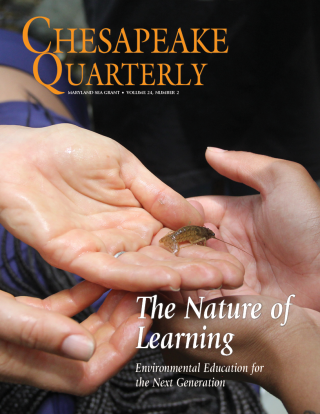Eight students will be presenting the summer work at the Ocean Sciences Meeting in March 2022!
The Maryland Sea Grant Bookstore will be closed for the winter holidays from Monday, December 15th to Friday, January 2nd and will not be taking orders during that time.
Lauren Rodriguez, Michigan State University
Class Year:
2019Mentor:
Helen Bailey, Ph.D.Project Title:
Modeling the Distribution of Bottlenose Dolphins (Tursiops truncatus) in the Chesapeake Bay as a Function of Environmental FactorsAbstract:
Bottlenose dolphins (Tursiops truncatus) are wide-ranging marine mammals that live in open-ocean habitats as well as coastal areas. However, little is known about their seasonal occurrence within the Chesapeake Bay, U.S.A, a highly urbanized region. The goal of this study was to determine the spatial and temporal distribution of bottlenose dolphins in the Chesapeake Bay using geospatial and statistical modeling techniques. Two years (2017-2018) of observational dolphin sighting data from a citizen-science initiative, Chesapeake DolphinWatch, was mapped using ArcGIS 10.5 to visually characterize dolphin occurrence. Sightings were then integrated with water quality data to identify factors significantly influencing dolphin occurrence in this area. We found a distinct seasonal occurrence pattern with dolphins being most commonly sighted in July. Using a generalized additive model, the probability of dolphin presence was found to be significantly affected by the tidal phase, water temperature, salinity levels, and dissolved oxygen. These results provide a better understanding of the geographical distribution and seasonal occurrence of bottlenose dolphins in the Chesapeake Bay. The relationship between dolphin occurrence and environmental conditions can be used to support conservation efforts and inform population management.
Location:
Chesapeake Biological LaboratoryREU Update
Graduate Research Assistant at the Bailey Lab, University of Maryland Center for Environmental SciencePublications:
Rodriguez, L.K.*, A.D. Fandel, B.R. Colbert, J.C. Testa, and H. Bailey. 2021. Spatial and temporal variation in the occurrence of bottlenose dolphins in the Chesapeake Bay, USA, using citizen science sighting data. PLOS ONE, https://doi.org/10.1371/journal.pone.0251637.
Presentations:
Rodriguez, L.*, and H. Bailey. 2019. Modeling the Distribution of Bottlenose Dolphins (Tursiops truncatus) in the Chesapeake Bay As a Function of Environmental Factors. SACNAS, Honolulu, Hawaii.





